Pabianice- Łódź 作者: 来源: 发布时间:2021-07-16
Ⅰ. Population and Area
Population (31 December 2019)
• Total 64,757 Decrease
Area
• Total 32.99 km2 (12.74 sq mi)
Website http://www.um.pabianice.pl
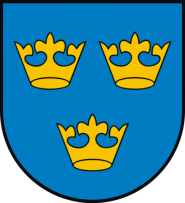
Ⅱ.Natural Geography (environment and resources)
-Pabianice, town and suburb of Łódź, in Łódzkie województwo (province), central Poland, in the Łódź Highlands on the Dobrzynka River. Pabianice is located in the Łódź agglomeration. They are also the center of a poviat with a population of 120,000. The most important institutions and offices for the community function here. The city has 62 thousand. inhabitants and covers an area of 33 km 2 .
-Transport
-Pabianice has seen major infrastructural changes over the past few years amidst increased investment and economic growth. The city has a much improved infrastructure with new roads. Pabianice now has a good circular road system. Pabianice bypass (express road S14) opened in May 2012. However, parts of S8 are currently under construction and to be completed within 2012.
-Near Pabianice there is an international airport: Łódź Władysław Reymont Airport (IATA: LCJ, ICAO: EPLL) located just 11 kilometres (7 miles) from the city centre.
-Public transport in Pabianice includes buses, trams (streetcars), as of 2013 commuter railway Łódzka Kolej Aglomeracyjna and regional rail PKP Przewozy Regionalne. The regional rail and light rail is operated by Polish State Railways (PKP). There are also some suburban bus lines run by private operators. Bus service covers the entire city. Currently, the Miejskie Przedsiębiorstwo Komunikacyjne (City Transport Company) company runs line number 41 which connects Pabianice with Łódź City.
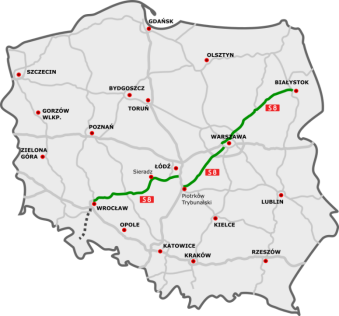
Ⅲ.Economy
-According to source data from 2009 average income per capita was on the level of 1844,96 PLN. According to source data from October 2011 average unemployment rate in Pabianice is on the level of 15,6%
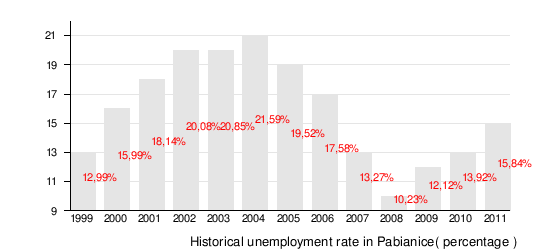
Pabianice - Wikipedia https://en.wikipedia.org/wiki/Pabianice#Unemployment
-Investment advantages of the city
-33 km 2 of the area
-65,700 inhabitants
-5,800 business entities
-location in the center of the country
-proximity to the A1 and A2 roads
-national road No. 14 running through Pabianice, connecting Łódź with Wrocław, Warsaw and Gdańsk
-proximity to the airport Władysław Reymont
-proximity to Łódź as a central economic, cultural and educational center
-location in the Łódź Metropolitan Area
-current spatial development plan
-rich business background
-favor and comprehensive assistance from local authorities
-Dla przedsiębiorcy - www.um.pabianice.pl - Oficjalny portal https://um.pabianice.pl/artykuly/80/dla-przedsiebiorcy
Ⅳ.Industrial Characteristics
-The second most important town in the surrounding industrial area, it lies on the Łódź-Wrocław rail line and is a major textile centre. Pabianice (päbyänē`tsĕ), city (1994 est. pop. 75,900), Łódzkie prov., central Poland, a suburb of Łódź. It has industries producing chemicals, machine tools, and textiles.
-A city in Poland, in -Łódź Województwo, within the Łódź conurbation. Out of a population of 65,000 (1973), about 25,000 persons are employed in industry. The city’s industries produce textiles (cotton, wool, silk, and industrial fabrics), electric lamps, cutting tools, grinding machine tools, pharmaceuticals, furniture, paper, and food (including meat packing).
-Key project
-1.Project "Remote School + within the National Educational Network"
-Projekty unijne - www.um.pabianice.pl - Oficjalny portal https://um.pabianice.pl/artykul/128/217/projekty-unijne
-2. The project "Reconstruction of Warszawska Street in Pabianice on the section from" Duży Skręcie "to the city limits with the construction of a rainwater and sanitary sewage system and lighting"
-Projekty unijne - www.um.pabianice.pl - Oficjalny portal https://um.pabianice.pl/artykul/128/217/projekty-unijne
-3. Project "Increasing digital competences of the inhabitants of the provinces: Kujawsko-Pomorskie and Łódzkie"
-Projekty unijne - www.um.pabianice.pl - Oficjalny portal https://um.pabianice.pl/artykul/128/217/projekty-unijne
Ⅴ.Attrations and Cityscape
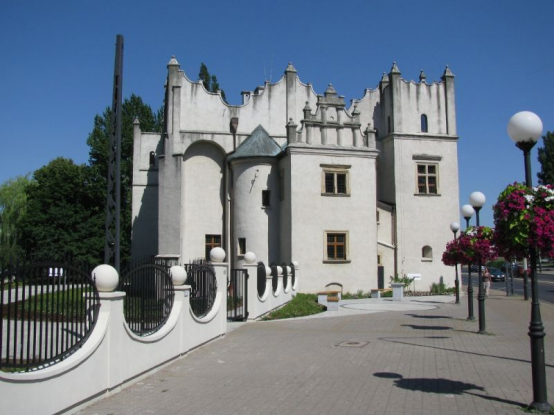
KRAKOW CAPITAL MANOR
-The court of the Krakow Chapter, the then owner of the Pabianice estates, built in the years 1566-1571 on the initiative of the tentary, canon Stanisław Dąbrowski. The work of the architect and builder of this Renaissance castle was done by Wawrzyniec Lorek. It belongs to the unique and valuable monuments of Polish architecture of the 16th century. Previously, there was a wooden manor house in this area, which until 1795 was the seat of the regents of the Krakow chapter. From 1833, the manor functioned as the town hall, which also housed a police detention facility. During World War II, the occupation authorities assigned it as their seat. Since 1948, the building has been at the disposal of the Pabianice City Museum.
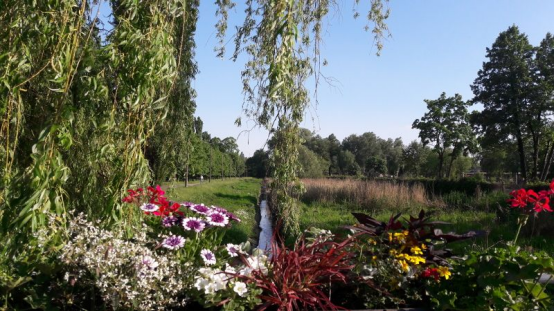
PARK IM. JULIUSZA SŁOWACKI
-On the banks of Dobrzynka, in the vicinity of the Pabianice Castle, there is a city park - an old garden for walking, established in 1901, with over a hundred years of history. Named after Juliusz Słowacki in 1918, in its original version it occupied the area on the left bank of the river and referred to the English gardens. It was extended with the right-bank part in 1931, arranged in the years 1935 - 1936 in the French style. During World War II, its name was changed to Pastor Zimmer Park and it was intended for use only by the Germans. After the war, a wooden concert shell was built in the park, under which concerts, festivals and rallies were held until the 1980s. Later, the shell burned down and was never rebuilt. In 2015, the park was revitalized and its former climate was largely restored. The park from the side of Zamkowa Street has been fenced off with a forged steel fence with three powerful gates. New flower discounts, a changed arrangement of park greenery and the reconstruction of the fountain in the shape of its pre-war shape made it easier for us to stroll along the park alleys today to imagine how the park looked decades ago.
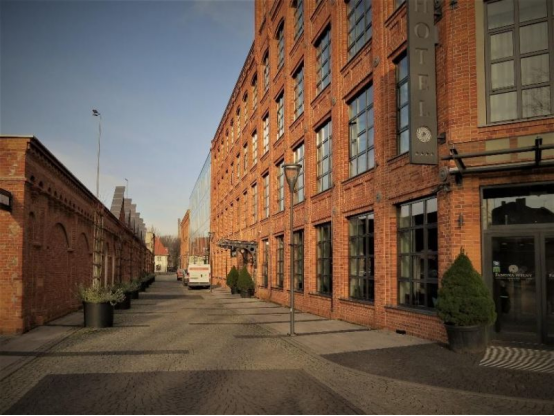
MOSIR "LEWITYN"
-The area called "Lewityn" is a former mill settlement with a large pond. In 1910, the lands were purchased from the Nawrocki family by the Joint Stock Society of the Chemical Industry in Pabianice CIBA. There was a mill, a house and other outbuildings. In July 1936, the chemical plants sold the settlement to the Levitin family, who ran it here for the next ten years. In 1946, as a result of the land reform, the Levitin State lost the rights to these areas. The repatriate Zygfryd Gryf-Kęszycki became the new host of "Lewitin". A few years later, a state-owned farm was established here. After another eight years, the farm was handed over to the Miejskie Przedsiębiorstwo Gospodarki Komunalnej and this is how MOSiR was created. The swimming pool was put into use by the residents of Pabianice in 1966. In 2016, Lewityn underwent a partial modernization. There, apart from relaxing in the water, you can work out in the gym "under the cloud", play tennis on the outdoor courts or beach volleyball or take a walk along the alleys. The youngest have their own playground here.
-BULWAR im. FELIKS KRUSCHIE
-Boulevard on Dobrzynką was established in the years 1932-1934 by tidying up the area on the river in the section between Grobelna streets and today's ul. Gen. Stefan "Grot" Rowecki. In 2008, it was named after Feliks Krusche, an entrepreneur of merit for Pabianice. Feliks Krusche (1872–1939), born in Pabianice, is the last co-owner of the most powerful cotton factory in this region, founded by his ancestors - industrialists. He was awarded the Gold Cross of Merit and the Officer's Cross of the Order of Polonia Restituta.
BARUCH'S FACTORY
-The former Barucha Factory is a complex of buildings located at Lipowa Street, between Zamkowa and Grobelna Streets, occupying an area that belonged to the "Bracia Baruchowie" company in the second half of the 19th century. It was a factory development typical for the Łódź district from the beginning of the 20th century. The Baruchów company specialized in the production of woolen and cotton fabrics. In the second half of In the nineteenth century, the Baruchs were high in Pabianice - third in terms of production and employment, right after the companies of Krusche, Ender and R. Kindler. In 1911, Oskar Krusche and Otto Fiedler - the new owners of the factory, started modernizing and expanding the factory. The next owners are Messrs. Hadrian and Fulde - entrepreneurs from Spółka Akcyjna Farbiarnie i Wykańczalnie “Dobrzynka”. After 1945, the factories were nationalized, The State Cotton Industry Plant "Dobrzynka", later "Pawelana" was established. Then the privatized plant was taken over by Ryszard Krusche. Unfortunately, it did not work for him, because the plant was brought into bankruptcy and the deserted buildings were devastated. Currently, the owner of the property is Aflopa. A sports and recreation complex with a Spa Hotel and restaurants, as well as a gym, bowling alley and conference rooms was built there.
-CHURCH OF St. MATTHEW THE APOSTLE AND THE EVANGELIST AND ST. WAWRZYŃCA Martyr
-One of the oldest monuments in Pabianice is the church of st. Matthew the Apostle and Evangelist and St. Lawrence of the Martyr, which stylishly combines late Gothic and Renaissance with a baroque interior. It was erected on the site of a wooden parish church that burned down in the town's fire in 1532. By the decision of the Krakow canon, Paweł Dębski, in the years 1583 - 1588, a brick temple was built according to the design and execution of the Ambrose Italian, resembling the shape of the Płock cathedral. The three-nave church was built of brick on a cross plan. Inside, we find mementoes closely related to the person of St. Maximilian Maria Kolbe, who received his First Holy Communion here and served as an altar boy during the Holy Mass. Here he also celebrated his primacy - the first mass solemnly celebrated by a newly ordained priest and praying in front of the altar of Our Lady of Consolation, he experienced a vision of two crowns, symbolizing a life of holiness and martyrdom. To this day, the most important ceremonies related to the celebration of national holidays are preceded by a mass in the st. Matthew and St. Lawrence.
-Weaver's house
-The Weaver's House is a two-story, wooden residential building, built in the Lusatian style in the 1820s - 30s of the 19th century, covered with a gable, half-hipped roof with two dormer windows, commonly known as "wolf's eye", located on each side of the roof. A half-timbered building with arcaded recesses on pillars around the walls, with windows embedded in them. A complete reconstruction was made in 1974, after a fire in the building. In 1989, the building suffered another fire. After five years it fell into private hands and for a long time remained undeveloped. In 2002, the building was thoroughly renovated, the ceilings, floors and windows were replaced, the stairs were reconstructed and the roofing was changed. A year later, the Wine Gallery was opened there, and then the building was converted into a restaurant and pub called "Dwa Księżyce".
-EVANGELIC-AUGSBURG CEMETERY
-The history of the cemetery of the Evangelical-Augsburg parish is related to the foundation of the community in 1818, or the regulation of the city in 1823. Set out in the vicinity of the existing Catholic cemetery, on land belonging to the Roman Catholic parish. Today's cemetery is partially separated from the Catholic cemetery by a brick, plastered wall. Near the entrance to the main avenue, a small wooden chapel from the 19th century has survived. In the corner of the cemetery, an Art Nouveau cemetery chapel, the former Kindler mausoleum, built in 1911, has survived to this day. The oldest tombstone of the cemetery is the tomb of Rachel Krusche from 1851. It is also easy to find the burial places of the well-known factory families of Pabianice Krusche and Ender.
-PKP STATION
-The railway station building, built of red brick, dates from the time when the railway was built in our area in 1901. It is a typical example of railway construction in Tsarist Russia. In the interwar period, the railway became a common means of communication, which was increasingly used by the inhabitants of Pabianice. The first major renovation of the building was carried out in 1934. At that time, 24 trains stopped here. You could get them by, among others. to Warsaw, Poznań, and even much further - to Berlin or Paris. The current condition of the station is due to the modernization that began in autumn 2010. It cost over PLN 2 million. The brick façade was renovated and all installations were replaced. A new roof and window frames were installed. New cash desks, kiosks and food outlets were located in the building. In front of the building, the MZK bus terminal has been renovated.
-FREEDOM PARK "STRZELNICA"
-Pabianicka "Strzelnica" is a park with almost a hundred years of history. In the protocols of the City Council of 1919 and 1920 we find a decision to create a municipal park in the area bought from the German Rifle Society (Pabianicer Bűrger Schűtzgűlde). The tradition of the Fowler Brotherhood operating in our area since 1853 has become the reason for the colloquial name of the park as "Strzelnica". Edward Natzel's company from Św. Jana Street transformed the surrounding wild and forested areas into a 36-hectare park, put into use in 1929. It was then completely fenced with the possibility of entering the park through one of three gates. Four ponds were created there, two of which were stocked with fish. There are benches and gazebos next to the alleys. There were also tennis courts in the park. After the war, in the 1970s, the park underwent major modernization. The paths were covered with asphalt, an amphitheater and a "health path" were built. In 1975, a monument to the heroic defenders of Pabianice against the Nazis - soldiers of the 15th Infantry Regiment "Wilków", designed by Antoni Białas, was unveiled. In the Wolności Park there are many species of interesting and old trees that can be admired while walking along the renovated alleys.
Ⅵ.History and Culture
-" Pabiański state"
-The origins of Pabianice date back to the Middle Ages, although the traces found in this area testify to the existence of human settlements already in prehistoric times (VI-V century BC). The settlement among a forest full of wild animals was located in the area known as Opole Chropskie (the name probably describes a marshy land, overgrown with bushes, which, freezing in winter, created terrain unevenness - "chropy"), it was one of the original forms of territorial community. Jan Długosz was the first to identify the messages of the 11th, 12th and 13th century sources about the territory of Chropów with the later key of the Pabianice properties of the Kraków Chapter. The famous chronicler wrote about this land that "more often a wild animal chose it as a lair than touched a farmer's plow". What was needed was a farmer capable of managing the fallow land. In 1086, Chropy was given to the Kraków Chapter by Judith, wife of prince Władysław Herman, reportedly as a victim in the intention of healing from long sterility. In the 11th century, the Krakow Chapter had 36 members: 6 prelates and 30 canons. Performing advisory functions alongside the bishop, the chapter looked after the Wawel cathedral, especially the cathedral liturgy. She had numerous privileges, festive costumes and distinctions. She also managed large estates. This special body consisted of eminent personalities, royal secretaries, most often church dignitaries to the state. The members of the chapter became bishops and even primate of Poland. Pabianice received city rights in the mid-fourteenth century, and three golden crowns on a silver background were adopted as the coat of arms. At that time, a parish was established here. In the 15th century, kings Władysław Jagiełło (1411, 1428, 1432) and Kazimierz Jagiellończyk (1463 and 1475). During his last visit to Pabianice, Jagiello received Czech envoys, concluding an agreement with them against the Teutonic Order. In 1555, the city was granted by Zygmunt August the privilege of establishing craft guilds. The king declared: "Desiring the city of Pabianice in the Sieradzka Region, belonging to the Krakow Chapter, in good management and order to maintain and encourage craftsmen, we established contuberally and fraternities:
-guild of blacksmiths, locksmiths, bit makers, cutters, cutters, sword-makers and other iron products
-features of rope makers, wheelwright, carpenters, coopers, carpenters and other woodworkers;
-the characteristics of cloth makers, cap makers, tailors, linen makers and others with wool and yarn;
-guilds of shoemakers, saddlers, saddlers, bag makers and other leather robots seized;
-guilds of furriers, leathermen and bakers
-In the second half of the 16th century, the chapter built two valuable Renaissance buildings that still exist today: the manor house (1571) known as the castle and the church of st. Matthew and St. Lawrence (1583). At the turn of the 16th and 17th centuries, in the period of its greatest prosperity, two towns, Pabianice and Rzgów, as well as 48 villages, created vast estates known as the "Pabian state". The local headquarters of the entire latifundial board was in Pabianice. It was the most valuable jewel in the endowment of the Krakow Chapter. However, fires, plagues, and army marches were not conducive to further rapid development. In 1715, Fr. Józef Jordan, the administrator of the Pabianice estates, established one of the first savings banks in Poland based on cooperative principles. He wanted to help the inhabitants of the "Pabiański state" to survive the difficult times. In 1794, Pabianice had only 482 inhabitants. They were of a craft and agricultural character. At the end of the 18th century, the 700-year-old "Krakow" period of the city's history came to an end.
-Promised Land
-The industrial face of the city was shaped in the 19th century. From 1825, experts from Bohemia, Silesia and Saxony came to the city. Thanks to customs and tax allowances guaranteed by the Kingdom of Poland, and also thanks to government subsidies, they had very favorable conditions for investing in industrial activities. There were rapid demographic changes. Citizens of German and Jewish nationality constituted a significant percentage of the population. On September 11, 1825, Bogumił Krusche, the founder of the Pabianice industrialists and financiers, came to the town. He started his activity with a manufacture associating six weaving workshops. In the mid-nineteenth century, Pabianice was already an industrial city with a textile profile. According to data from 1848, there were 6 large cotton factories with 636 employees, and the image of the industrial momentum is completed by 54 independent weaving masters with 535 apprentices and students. Pabianice was inhabited by 4,128 people, and 26 percent of them made a living from textiles. In 1850, Beniamin Krusche, son of Bogumił, brought the first steam engine to Pabianice. The era of the technical revolution has begun. The Beniamin Krusche factory has outpaced its competitors. In 1853, it already employed 202 workers and absorbed several weaker enterprises. In 1859, Rudolf Kindler's second-largest factory was established in Pabianice, and it took 20 years to catch up with the competitive Krusche factory. Until the mid-sixties, only textile industry developed. It was not until 1865 that a paper factory was opened, and in 1889 a chemical factory. The abolition of serfdom duties made it possible for the villagers to seek work in the city. A new social class emerged - the workers. The last quarter of the nineteenth century was a time of capital mergers that resulted in the formation of the great industrial bourgeoisie. At the end of the 19th century, it was based on the companies Krusche and Ender, Kindler and the Chemical Factory CIBA. At that time, Pabianice was second only to Łódź in terms of the production of cotton, wool and mixed fabrics. Pabianice has become an essential part of the Promised Land. This was the name of a place where you could do good business, work and earn a decent income. At that time, Pabianice was second only to Łódź in terms of the production of cotton, wool and mixed fabrics. Pabianice has become an essential part of the Promised Land. This was the name of a place where you could do good business, work and earn a decent income. At that time, Pabianice was second only to Łódź in terms of the production of cotton, wool and mixed fabrics. Pabianice has become an essential part of the Promised Land. This was the name of a place where you could do good business, work and earn a decent income.
-At the end of the century, the first pharmacy, bookstore, printing house, fire department and trade school were established in the city. A telegraph station and a workers' housing estate were built, Zamkowa Street was lit with electric lamps. The further development of the city brought about the turn of the 19th and 20th centuries. In 1900, Pabianice was connected with Łódź by an electric tram line, in 1901 a railway station was built along the Warsaw-Kalisz railway route, and in 1909 a city hospital, a bank was established. Two churches have been completed. There has been a revival of the cultural and social life. Factory libraries, sports societies and a museum were created. The first local newspaper and cinematograph appeared. During World War I, a female gymnasium was established. For one hundred years, Pabianice was part of the Russian Empire.
-Between the wars
-World War I was another decline in the population and the economy of the German occupier. The inhabitants of Pabianice took part in the fight for independence, serving in the Legions, the Polish Military Organization and other military formations. The inhabitants of Pabianice who died in the fighting in 1914-1921 were erected the Monument of Independence, also known as the Monument of the Legionnaire. The years 1918-39 were marked by the development of education, the creation of cultural and educational institutions and numerous associations. Male and female gymnasiums were nationalized, several schools and two cinemas were added, and a light bulb factory was opened - OSRAM Werke Gmbh Kommanditgesesellschaft. Pabianice obtained a telephone exchange. The city was electrified and an estate of workers' houses was built. A municipal library was established and Gazeta Pabianicka started its activity. Lively local government activity was flourishing, reflecting the pluralism of economic and political interests. The community was colorful, market-oriented, socially and economically diverse - large and middle bourgeoisie, craftsmen, intelligentsia, workers, farmers and multi-ethnic - Poles, Germans, Jews. The development of Pabianice was stopped by the great economic crisis and the outbreak of World War II.
-In September 1939, on the outskirts of the city, the so-called the battle of Pabianice. In battles conducted, among others many Polish soldiers were killed by the 15th Infantry Regiment "Wilków". The "Wolves" clashed with the notorious SS Leibstandarde Adolf Hitler regiment. The 36th Infantry Regiment of the Academic Legion and 72nd Infantry Regiment named after Dionizy Czachowski also fought in defense of the city. During the Nazi occupation, the city belonged to the Third Reich. The Germans annihilated the Pabianice ghetto in the Old Town, in which there were approx. 9 thousand people. Jews. The local community was subject to racist repression. The underground Home Army and the Gray Ranks operated in the city. On January 19, 1945, Soviet troops of the 1st Belorussian Front entered the city.
-After war
-After 1945, Pabianice is recovering from the war damage, the city grows and expands territorially. Industry nationalization takes place. Workers dominate the social structure. The city is nationally homogeneous. New schools, health, sports, culture and recreation centers are being built - new districts - "blocks of flats", incl. "Piaski" in the south-west and "Bugaj" in the south-east. New plants are emerging - the post-war factory of light bulbs "Polam", Zakłady Środków Opatrunkowych, Zakład Budowy Maszyn Drogowych Madro and others. The largest enterprises in the Lodzkie Voivodship were Pabianickie Zakłady T Materiał Technicznych and PZPB "Pamotex" (former Krusche & Ender plants), employing almost 10,000 people at its peak. Pabianice was included in the group of model socialist cities. In 1967 The Council of State, in recognition of its contribution to the political and economic life of the country, awarded the city with the Order of the Banner of Labor, 1st class. After 1989, there was a political transformation, followed by the IT revolution. The business activity is being privatized. Numerous small and medium-sized companies are established. Foreign capital appears, incl. Philips Lighting Poland SA, retail chains and banks. There is a revival and pluralisation of social activity, incl. within non-governmental organizations. The city restores old traditions and refers to its rich history. In 1994, the solemn consecration of the Church of st. Maximilian Kolbe. The saint became the patron of the city in 2004, and the proclamation was made by John Paul II, from 1999 an Honorary Citizen of the City. In 1999, the city became the seat of the newly established Pabianice poviat.
Ⅶ.Other Information
-Pabianice is a town in central Poland with 64,757 inhabitants Situated in the Łódź Voivodeship, it is the capital of Pabianice County. It lies about 10 kilometres (6 miles) southwest of Łódź and belongs to the metropolitan area of that city. It is the third largest city in the Łódź Voivodeship by population. The area of the city covers 32.9 square kilometres (12.7 sq mi) being the 10th largest in Łódź Voivodeship.
-According to data from 2009 Pabianice covers 32.99 km2 (13 sq mi) with following split: agricultural land: 53%, forests: 9%. The city covers 6.70% of Pabianice County.
-Neighbour administrative divisions: gmina Dobroń, gmina Ksawerów, miasto Łódź, gmina Pabianice, gmina Rzgów.
Ⅷ.Contact Information
Mayor Grzegorz Mackiewicz
Website http://www.um.pabianice.pl
Town Hall in Pabianice ul. Zamkowa 1695-200 Pabianice
Phone: 42 22 54 600
E-mail: Pocztowy@um.pabianice.pl
